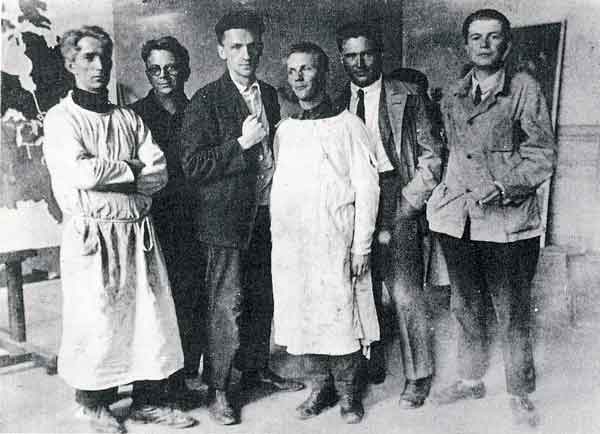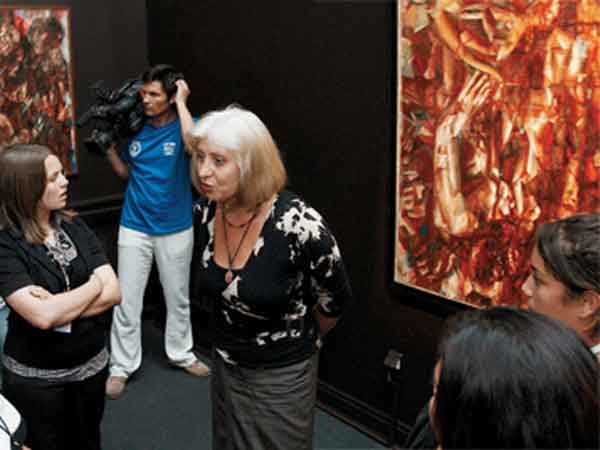MAI - Filonov's School - Mastera Analiticheskogo Iskusstva - МАИ - Мастера Аналитического Искусства
1925 - 1932, Member List
Pavel Filonov has first introduced the principles of his analytical art in the 1914 essay "Sdelannye kartiny" ("Made Paintings"). His work was interrupted by WWI, during which he was called to serve on the Romanian front, but after the Revolution he has returned to Petrograd and began a period of great artistic activity. While teaching at the INKhUK (Institute of Artistic Culture) Filonov has worked perfecting his theories, and in 1925 he has opened a workshop and a group of students, called the Masters of Analytical Art - MAI, informally known as filonovtzy.
Filonov was an energetic, demanding teacher, making his students draw for hours at a time, without meal breaks. As they worked, Filonov would lecture on his artistic ideology with great energy. Even those not always agreeing with his theories felt his leadership and charisma. Those who knew Filonov well saw him as made up of "burning coals, smoldering logs, the heart of a tree scorched by lightening". His methods were soon recognized as a distinct school of art and his students frequently held exhibitions at the House of the Press.
In 1923 Filonov has issued his "Declaration of Universal Flowering", in which he described the principles of "madness" as the basis for Analytical Art:
"...I know, analyze, see and intuitively feel the existence in any object of not just two predicates - form and color - but a whole world of seen and unseen characteristics, along with their expressions, reactions, inclusions, causes and separate realities; as well as properties known and unknown which sometimes contain infinite predicates of their own. Thus I categorically denounce as unscientific the dogma of contemporary Realism of 'two predicates' with all of its right- and left-winged followers. In its place I propose a scientific, analytical and intuitive naturalism: the observer's acknowledgment of all of the object's predicates, all the parameters of its entire world, and also the characteristics of human processes, both seen and unseen by the naked eye. I propose persistence of the master and the principle of a 'Biologically made' painting".
Understanding comes from the analysis of the object and all its parameters, and the artist is then able to synthesize what he sees into a harmonious vision. Filonov makes a distinction between between the "seeing" eye and the "knowing" eye. The seeing eye is only able to perceive two attributes of an object - color and form; but the knowing eye can intuitively sense the many hidden processes in it, bringing more complete understanding. The spectator's eye, like the artist's, is to be "knowing" in order to see in the depiction of the object as much as the artist saw in the object itself. In his strictly-organized paintings Filonov sought to convey not only the essence of things, but also the philosophical questions they implied. Even though many of Filonov's paintings depict only a certain aspect of the Universe, a particular "micro-world", the intuition informing them leads to a sense of universality in the paintings, a convergence of all the aspects of nature, seen, unseen or felt.

Group MAI (left to right):
E.Tennisman, V.Luppian, V.Sulimo-Samuilo, M.Tzybasov, E.Kibrik, H.Evgrafov. 1927.
Filonov's technique concentrates primarily on analysis of the most minute parts of the universe: atoms, not masses, which makes the universal effect of art is all the more startling. Filonov's world contains countless small worlds, as moments of existence, each whole and complete in itself. Only through the part could one hope to consider the whole. Often Filonov began to paint from one corner of the canvas, convinced that a painting must grow and evolve as plants grow in nature, orderly and organic - atom by atom, cell by cell. In a letter to one of his students Filonov taught: "Think persistently and accurately about each atom of a thing being made. Draw each atom persistently and accurately". His idea of a "biologically-made painting" is to be taken literally. Manifestation of the organic growth and gradual transformation may be seen, for example, in the plant-growth on faces to artistically symbolize the "intermediate step between the plant and animal worlds". The paintings were gradually brought to a state of sdelannost', or "madeness".
The group has participated in many projects, such as designing the play "Revisor" by Gogol in the House of the Press, produced by I.Terentyev in 1927, and the play "Activist Gaikin" in the club "Vasileostrovsky metallist" in 1929. They illustrated the Karelian-Finnish epos "Kalevala", published in 1933 by "Academia".
Many students have studied with Filonov, but only some remained from the original group till Filonov's death in 1941: N.Evgrafov, T.Glebova, A.Poret, S.Zaklikovskaya and several others.

Exhibition of Pavel Filonov in the State Russian Museum, 2006.
Photo from journal "Ogoniok" #30, at www.ogoniok.com.
